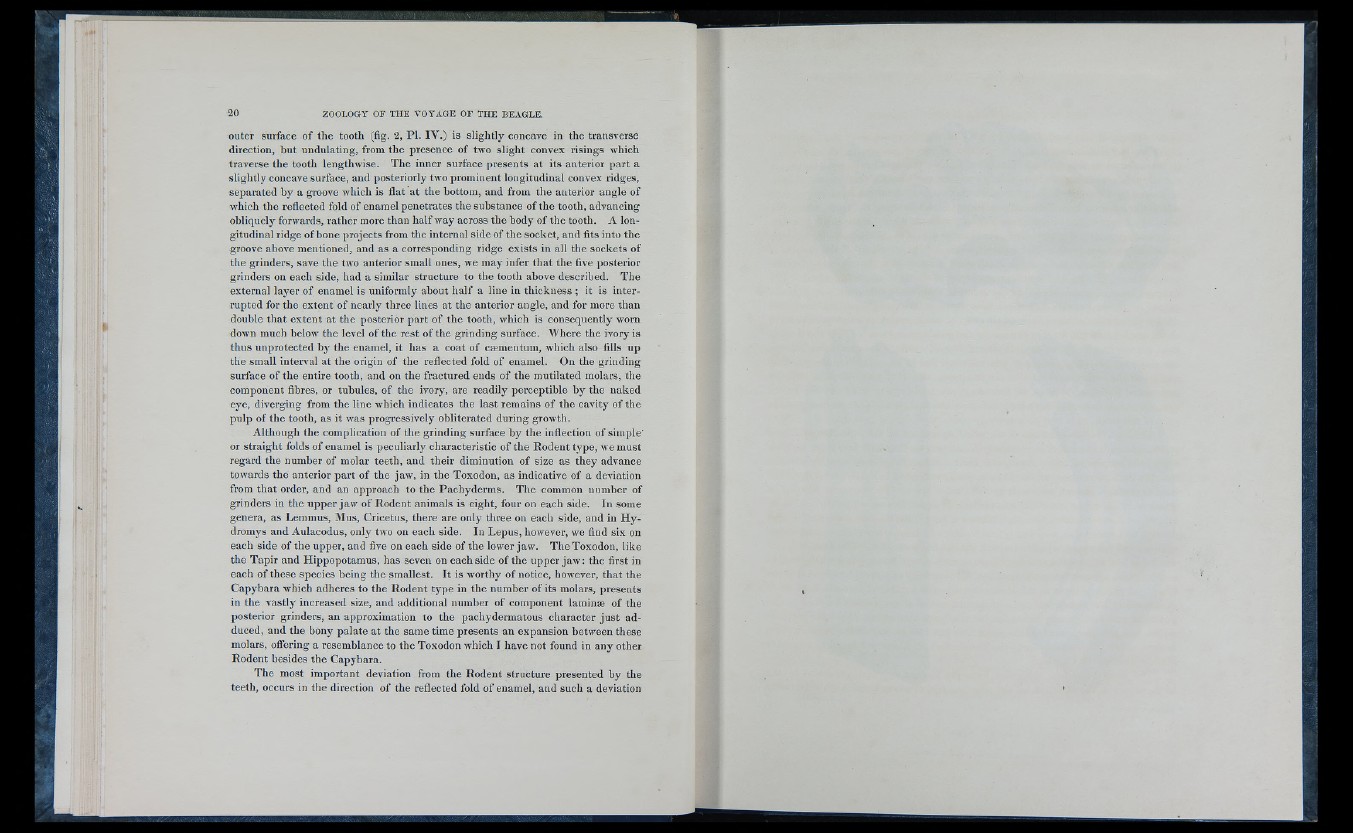
outer surface o f the tooth (fig. 2, PL IV .) is sligh tly concave in the transverse
direction, but undulating, from the presence o f two slight convex risings which
traverse the tooth lengthwise. The inner surface presents at its anterior part a
slightly concave surface, and posteriorly two prominent longitudinal convex ridges,
separated by a groove which is flat 'at the bottom, and from the anterior angle o f
whicli tlie reflected fold o f enamel penetrates the substance o f the tooth, advancing
obliquely forwards, rather more than half way across the body o f the tooth. A longitudinal
ridge o f bone projects from the internal side of the socket, and fits into the
groove above mentioned, and as a corresponding ridge e x ists in all the sockets o f
the grinders, save the two anterior small ones, we may infer that the five posterior
grinders on each side, had a similar structure to the tooth above described. The
external layer o f enamel is uniformly about h a lf a line in thickness ; it is interrupted
for the extent o f nearly three lines at the anterior angle, and for more than
double that ex ten t at the posterior part o f the tooth, which is consequently worn
down much below the level o f the rest o f the grinding surface. Where the ivory is
thus unprotected by the enamel, it has a coat o f cæmentum, which also fills up
the small interval at the origin o f the reflected fold o f enamel. On the grinding
surface o f the entire tooth, and on the fractured ends o f the mutilated molars, the
component fibres, or tubules, o f the ivory, are readily perceptible by the naked
eye , diverging from the line which indicates the la st remains o f the cavity o f the
pulp o f the tooth, as it was progressively obliterated during growth.
Although the complication o f the grinding surface b y the inflection o f simple'
or straight folds o f enamel is peculiarly characteristic o f the Rodent type, we must
regard the number o f molar teeth, and their diminution o f size as they advance
towards the anterior part o f the jaw, in the Toxodon, as indicative o f a deviation
from that order, and an approach to the Pachyderms. The common number of
grinders in the upper jaw o f Rodent animals is eight, four on each side. In some
genera, as Lemraus, Mus, Cricetus, there are only three on each side, and in H y -
dromys and Aulacodus, only two on each side. In Lepus, however, we find six on
each side o f the upper, and five on each side o f the lower jaw. The Toxodon, like
the Tapir and Hippopotamus, has seven on each side o f the upper jaw: the first in
each o f these spe cie s being the smallest. It is worthy o f notice, however, that the
Capybara which adheres to the Rodent type in the number o f its molars, presents
in the v a stly increased size, and additional number o f component laminæ o f the
posterior grinders, an approximation to the pachydermatous character ju st adduced,
and the bony palate at the same time presents an expansion between these
molars, oflering a resemblance to the Toxodon which I have not found in any other
Rodent besides the Capybara.
The most important deviation from the Rodent structure presented by the
teeth, occurs in the direction o f the reflected fold o f enamel, and such a deviation